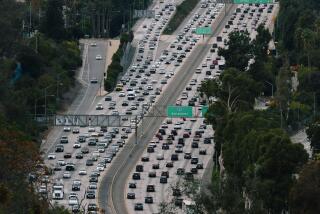Aftermath of Huge Pileup on I-10: Paperwork
- Share via
COLTON — It wasn’t so much the downpour as it was the sudden appearance of the bright, low sun--coupled with the water vapor and spray from wet pavement--that blinded drivers.
The result was the unnerving sound of crunching metal, and when it was over, the largest collection of spontaneous collisions in Southern California memory.
About 57 separate crashes--three vehicles here, five there, 200 altogether--littered 13 miles of the westbound San Bernardino Freeway through the belly of the Inland Empire on Wednesday night, putting the California Highway Patrol, tow truck drivers, paramedics and emergency rooms to the test.
By Thursday, most of the 78 injured motorists had been treated and released, leaving investigators and insurance firms with a mound of paperwork. No one died and a few were hospitalized, the worst being an elderly woman airlifted to Loma Linda University Medical Center with serious injuries.
“When I first got to the scene, I saw the first accident involving three or four cars, then another collision with four or five cars, and the more I drove, the more crashes I saw,” said CHP Officer Oscar Medellin.
“It would have been easier, in terms of taking reports, if it was a single chain reaction,” he said. Instead, the CHP was writing up reports on each collision, from Pepper Avenue in Colton west to Etiwanda Avenue in Fontana, that all occurred within minutes.
The first CHP officers drove the entire length to direct paramedics to the most seriously injured. By then, at least one vehicle fire was put out by motorists with extinguishers.
According to the CHP and witnesses, the accidents were triggered by glare that resulted when a heavy downpour was followed by a break in the clouds leaving westbound motorists facing directly into the setting sun. The situation was exacerbated by water vapor coming off the pavement and spray from vehicles ahead, all but blinding many motorists who quickly slowed--only to be rear-ended.
“People just don’t slow down” in bad weather, said CHP Officer Michelle Reddick. “They maintain their speed until something happens in front of them, then they panic. The big thing is, motorists have to reduce their speed and increase their distance between vehicles.”
Typical of the stories told Wednesday night was this accounting by Mercedes Cuevas, 18, of San Bernardino, who was headed for a night of bowling:
“The cars [in front of us] just stopped, and we were coming to a stop, but a white car from behind was going too fast. He cut in front of us, hit us and we spun. He hit four more cars. . . .
“It was horrible. A lot of cars crashed. A lot of people were freaking out. They were, like, running. Screaming, like they thought their cars were going to blow up. They didn’t even wait for traffic to stop--they were already out of their cars, running.”
The crashes occurred shortly after 6 p.m. Within minutes the 911 emergency lines were jammed with calls, many from motorists with cell phones.
The CHP called in off-duty officers--and requested backup from as far away as Santa Fe Springs, Lake Arrowhead and Banning.
Sheriff’s deputies and police officers shut off freeway onramps.
Thirty-one ambulances ferried 48 people to nearby hospitals; 30 others were treated on the freeway for minor injuries, said emergency officials. One of the first ambulances on the scene was itself rear-ended, and its crew rushed on foot to treat some of the injured.
It took nearly six hours to clear the freeway, with the help of no fewer than 70 tow trucks.
*
Times Community News reporter Darla Martin Tucker contributed to this article. Schweizer, of Times Community News, reported from Colton. Gorman, a Times staff writer, reported from Riverside.
More to Read
Sign up for Essential California
The most important California stories and recommendations in your inbox every morning.
You may occasionally receive promotional content from the Los Angeles Times.










